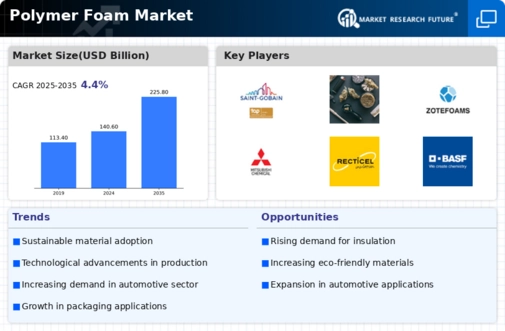Market Growth Projections
The Global Polymer Foam Market Industry is poised for substantial growth, with projections indicating a market value of 140.6 USD Billion in 2024 and an anticipated increase to 225.8 USD Billion by 2035. This growth trajectory suggests a compound annual growth rate of 4.4% from 2025 to 2035, reflecting the expanding applications and innovations within the polymer foam sector. The market's evolution is driven by various factors, including technological advancements, increased demand in automotive and construction sectors, and a growing emphasis on sustainability. These projections highlight the dynamic nature of the polymer foam market and its potential for future expansion.
Growth in Construction Activities
The construction sector is experiencing a renaissance, with polymer foams playing a crucial role in insulation and structural applications. The Global Polymer Foam Market Industry benefits from the increasing emphasis on energy-efficient buildings, where these materials provide superior thermal insulation and soundproofing. As urbanization accelerates globally, the demand for innovative construction materials is likely to surge. This trend is supported by government initiatives promoting sustainable building practices. The anticipated growth in the construction sector is expected to bolster the market, potentially leading to a valuation of 225.8 USD Billion by 2035, underscoring the importance of polymer foams in modern construction.
Increased Application in Packaging
The packaging industry is increasingly adopting polymer foams due to their lightweight and protective properties. In the Global Polymer Foam Market Industry, these materials are essential for cushioning and protecting products during transportation. The rise of e-commerce and the need for sustainable packaging solutions are propelling the demand for polymer foams. As businesses seek to minimize damage during shipping while adhering to environmental regulations, the market for polymer foam packaging is expected to expand. This trend is indicative of a broader shift towards sustainable practices in packaging, further solidifying the role of polymer foams in the industry.
Rising Demand in Automotive Sector
The automotive industry is witnessing a substantial increase in the utilization of polymer foam materials, driven by the need for lightweight components that enhance fuel efficiency. In the Global Polymer Foam Market Industry, polymer foams are increasingly employed in seating, insulation, and soundproofing applications. This shift is indicative of a broader trend towards sustainability and energy efficiency. As the automotive sector evolves, the demand for polymer foams is projected to rise, contributing to the market's growth. The market is expected to reach 140.6 USD Billion in 2024, reflecting the automotive industry's pivotal role in shaping the future of polymer foam applications.
Growing Consumer Awareness of Sustainability
Consumer awareness regarding sustainability is influencing purchasing decisions across various sectors, including the Global Polymer Foam Market Industry. As individuals become more environmentally conscious, there is a marked shift towards products made from sustainable materials, including polymer foams. This trend is prompting manufacturers to innovate and develop eco-friendly foam solutions, thereby enhancing their market appeal. The increasing preference for sustainable products is likely to drive demand for polymer foams, as companies strive to align with consumer values. This evolving landscape suggests a promising future for the market, as sustainability becomes a central theme in product development.
Technological Advancements in Foam Production
Innovations in polymer foam production technologies are significantly enhancing the efficiency and quality of these materials. The Global Polymer Foam Market Industry is benefiting from advancements such as improved manufacturing processes and the development of bio-based foams. These technologies not only reduce production costs but also cater to the growing consumer demand for environmentally friendly products. As manufacturers adopt these innovations, the market is likely to experience a compound annual growth rate of 4.4% from 2025 to 2035. This growth trajectory indicates a robust future for polymer foams, driven by technological progress and sustainability considerations.



















